Porosity Evaluation of Concrete Containing Supplementary Cementitious Materials for Durability Assessment through Volume of Permeable Voids and Water Immersion Conditions
Abstract
:1. Introduction
2. Experimental Program
- →
- This method provides a good estimate of total porosity, as it is based on the concept that the weight of an object is due to the absolute mass of a solid. In this test, the pores of the specimen are filled with a liquid medium of a known density, known as conditioning water, and hence the total effective porosity can be calculated from the change in weight.
- →
- The last water absorption test for measurement of porosity conducted in this present study conforms to ASTM C 642-97 where the specimens are oven dried at a temperature of 110.5 °C for no less than 24 h, then immersed in the water for 48 h. The specimens were then subjected to water boiling in metal containers and a hot plate for five hours, followed by cooling for fourteen hours by immersion in water. The mass of the specimens is recorded during each of the steps as per ASTM C642. The water absorption by concrete specimens is reported after immersion and boiling as percentage in volume of permeable pore spaces.
- →
- A Rapid Chloride Ion Penetration test in accordance with ASTM C1202-19 was also conducted on concrete specimens of all five concrete mixes. The setup of RCP tests conducted on all specimens for five concrete mixes is shown in Figure 3. The results of water absorption by concrete specimen are related to respective RCP test ratings for all investigated concrete mixes, OPC + GGBS concrete mixes and concrete mixes containing GGBS only. Developing this relationship between water absorption and RCP ratings is crucial, owing to criticisms of RCP tests.
3. Results and Discussion
3.1. Porosity of SCM Concrete Mixes by Four Standard Test Methods
3.2. Impact of SCMs on Porosity of Concrete Mix
3.3. Porosity and RCP of Environmentally Sustainable Concrete
3.4. Rapid Chloride Penetration Ratings for Concrete Mixes Containing SCMs
4. Conclusions
Author Contributions
Funding
Institutional Review Board Statement
Informed Consent Statement
Data Availability Statement
Conflicts of Interest
References
- Khartabil, A.; Martini, S.A. Thermal Transmission Properties of Sustainable Concrete with Supplementary Cementitious Materials. Key Eng. Mater. 2020, 853, 142–149. [Google Scholar] [CrossRef]
- Al Martini, S.; Khartabil, A. Bulk Electrical Conductivity to Assess Chloride Penetration in Reinforced Concrete Bridges. In Proceedings of the 10th International Conference on Short and Medium Span Bridges, Quebec City, QC, Canada, 31 July–3 August 2018. [Google Scholar]
- Saraswathy, V.; Song, H.W. Evaluation of Cementitious Repair Mortars for Corrosion Resistance. Port. Electrochim. 2008, 26, 417–432. [Google Scholar] [CrossRef]
- Dean, S.; Montes, F.; Valavala, S.; Haselbach, L.M. A New Test Method for Porosity Measurements of Portland Cement Pervious Concrete. J. ASTM Int. 2005, 2, 1–13. [Google Scholar] [CrossRef]
- Malecot, Y.; Zingg, L.; Briffaut, M.; Baroth, J. Influence of free water on concrete triaxial behavior: The effect of porosity. Cem. Concr. Res. 2019, 120, 207–216. [Google Scholar] [CrossRef]
- Accary, A.; Malecot, Y.; Daudeville, L. Design and Evaluation of a Deformable Sensor for Interstitial Pore Pressure Measurement in Concrete under Very High Stress Level. Appl. Sci. 2019, 9, 2610. [Google Scholar] [CrossRef] [Green Version]
- Baroth, J.; Briffaut, M.; Vu, D.; Malecot, Y.; Daudeville, L. Prediction of perforation into concrete accounting for saturation ratio influence at high confinement. Int. Jr. Impact Eng. 2021, 156, 103293. [Google Scholar] [CrossRef]
- Khalaf, F.M.; DeVenny, A.S. New Tests for Porosity and Water Absorption of Fired Clay Bricks. J. Mater. Civ. Eng. 2002, 14, 334–337. [Google Scholar] [CrossRef]
- Khartabil, A.; Al Martini, S. Carbonation Resistance of Sustainable Concrete Using Recycled Aggregate and Supplementary Cementitious Materials. Key Eng. Mater. 2019, 803, 246–252. [Google Scholar] [CrossRef]
- Ding, S.; Liang, X.; Zhang, Y.; Fang, Y.; Zhou, J.; Kang, T. Capillary Water Absorption and Micro Pore Connectivity of Concrete with Fractal Analysis. Crystals 2020, 10, 892. [Google Scholar] [CrossRef]
- Zhuang, S.; Wang, Q. Inhibition mechanisms of steel slag on the early-age hydration of cement. Cem. Concr. Res. 2021, 140, 106283. [Google Scholar] [CrossRef]
- Chen, Q.; Ma, R.; Li, H.; Jiang, Z.; Zhu, H.; Yan, Z. Effect of chloride attack on the bonded concrete system repaired by UHPC. Constr. Build. Mater. 2021, 272, 121971. [Google Scholar] [CrossRef]
- Wang, D.; Wang, Q.; Huang, Z. Reuse of copper slag as a supplementary cementitious material: Reactivity and safety. Resour. Conserv. Recycl. 2020, 162, 105037. [Google Scholar] [CrossRef]
- Bao, J.; Yu, Z.; Wang, L.; Zhang, P.; Wan, X.; Gao, S.; Zhao, T. Application of ferronickel slag as fine aggregate in recycled aggregate concrete and the effects on transport properties. J. Clean. Prod. 2021, 304, 127149. [Google Scholar] [CrossRef]
- Zhang, S.P.; Zong, L. Evaluation of relationship between water absorption and durability of concrete materials. Adv. Mater. Sci. Eng. 2014, 14, 1–8. [Google Scholar] [CrossRef] [Green Version]
- Claisse, P.A.; Cabrera, J.G.; Hunt, D.N. Measurement of porosity as a predictor of the durability performance of concrete with and without condensed silica fume. Adv. Cem. Res. 2001, 3, 165–174. [Google Scholar] [CrossRef]
- Pinto, S.R.; Macedo, A.L.A.; Medeiros Junior, R.A. Effect of preconditioning temperature on the water absorption of concrete. J. Build. Pathol. Rehabil. 2018, 3, 1–10. [Google Scholar] [CrossRef]
- Liu, R.; Liu, H.; Sha, F.; Yang, H.; Zhang, Q.; Shi, S.; Zheng, Z. Investigation of the porosity distribution permeability and mechanical performance of pervious concretes. Processes 2018, 6, 78. [Google Scholar] [CrossRef] [Green Version]
- Neville, A.M.; Brooks, J.J. Concrete Technology; Pearson Education Limited: London, UK, 2010; Volume 12. [Google Scholar]
- Li, Y.; Dong, W.; Li, H.; Li, W. Method of vacuum water absorption to determine the porosity of hardened concrete. Int. J. Struct. Civ. Eng. Res. 2015, 4, 282–286. [Google Scholar] [CrossRef]
- Concrete Institute of Australia. Concrete Durability Series Z7/07: Performance Tests to Assess Concrete Durability; Engineers Media: North Sydney, Australia, 2015. [Google Scholar]
- Cantero, B.; Bravo, M.; deBrito, J.; Sáez del Bosque, I.F.; Medina, C. Assessment of the Permeability to Aggressive Agents of Concrete with Recycled Cement and Mixed Recycled Aggregate. Appl. Sci. 2021, 11, 3856. [Google Scholar] [CrossRef]
- Sakir, S.; Raman, S.N.; Safiuddin, M.; Kaish, A.B.M.A.; Mutalib, A.A. Utilization of by-products and wastes as supplementary Cementitious Materials in Structural Mortar for Sustainable Construction. Sustainability 2020, 12, 3888. [Google Scholar] [CrossRef]
- Joshi, P.; Chan, C. Rapid chloride permeability testing. Concr. Constr. 2002, 47, 37–43. [Google Scholar]
- Moini, M.; Sobolev, K.; Flores-Vivian, I.; Muzenski, S.; Pham, L.T.; Cramer, S.; Beyene, M. Durability of Concrete Mixtures Containing Supplementary Cementitious Materials in Rapid Chloride Permeability Test. ACI Mater. J. 2019, 115, 67–76. [Google Scholar] [CrossRef]

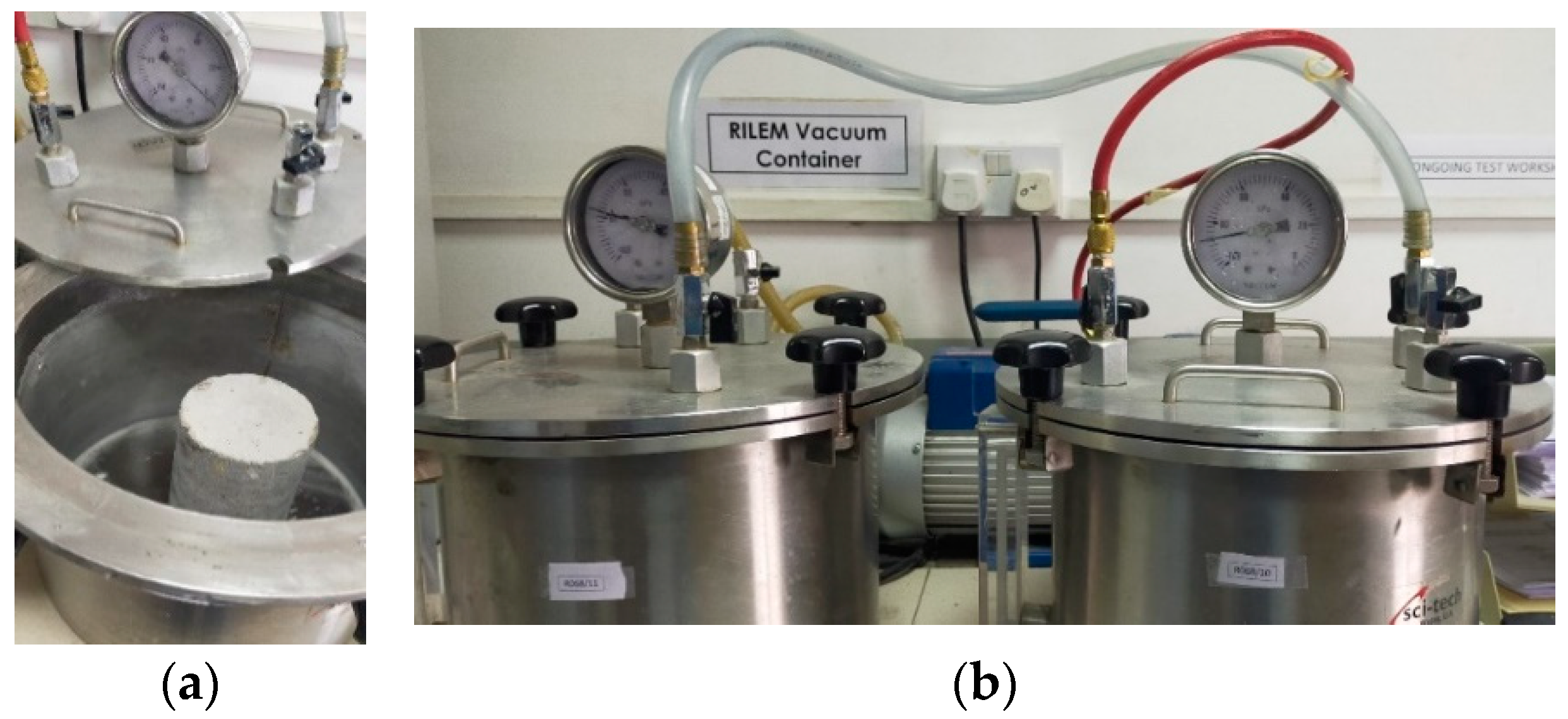

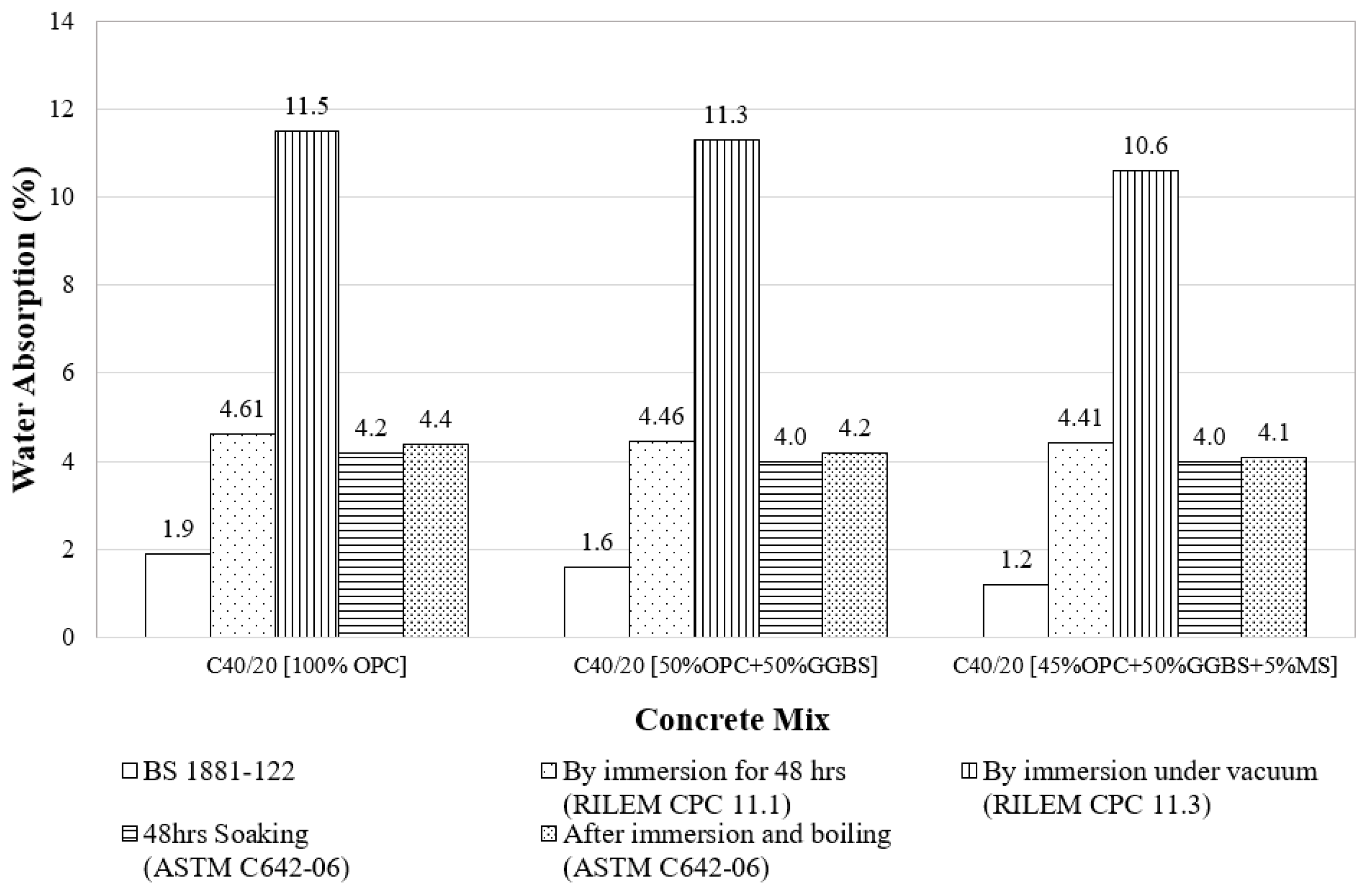
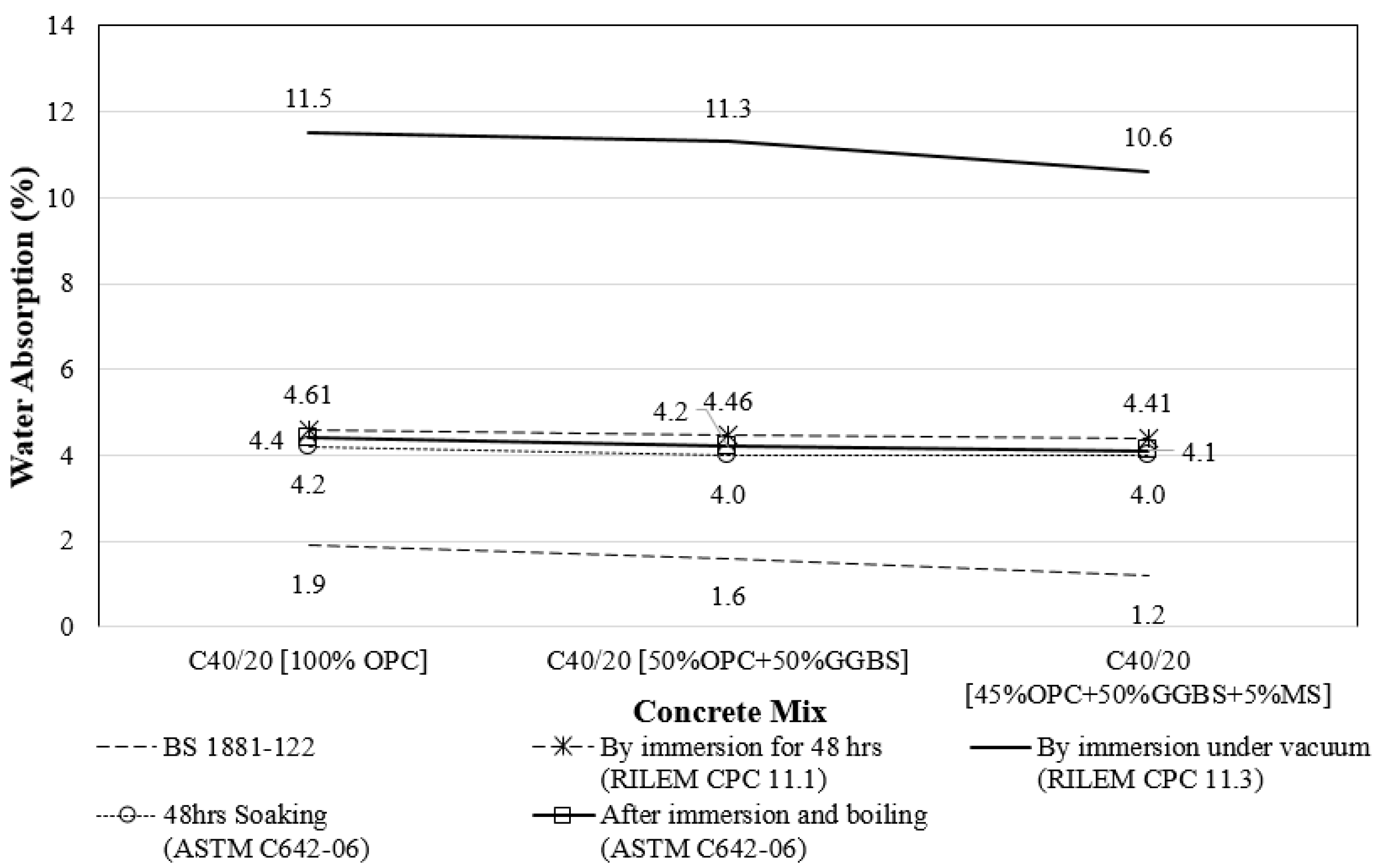
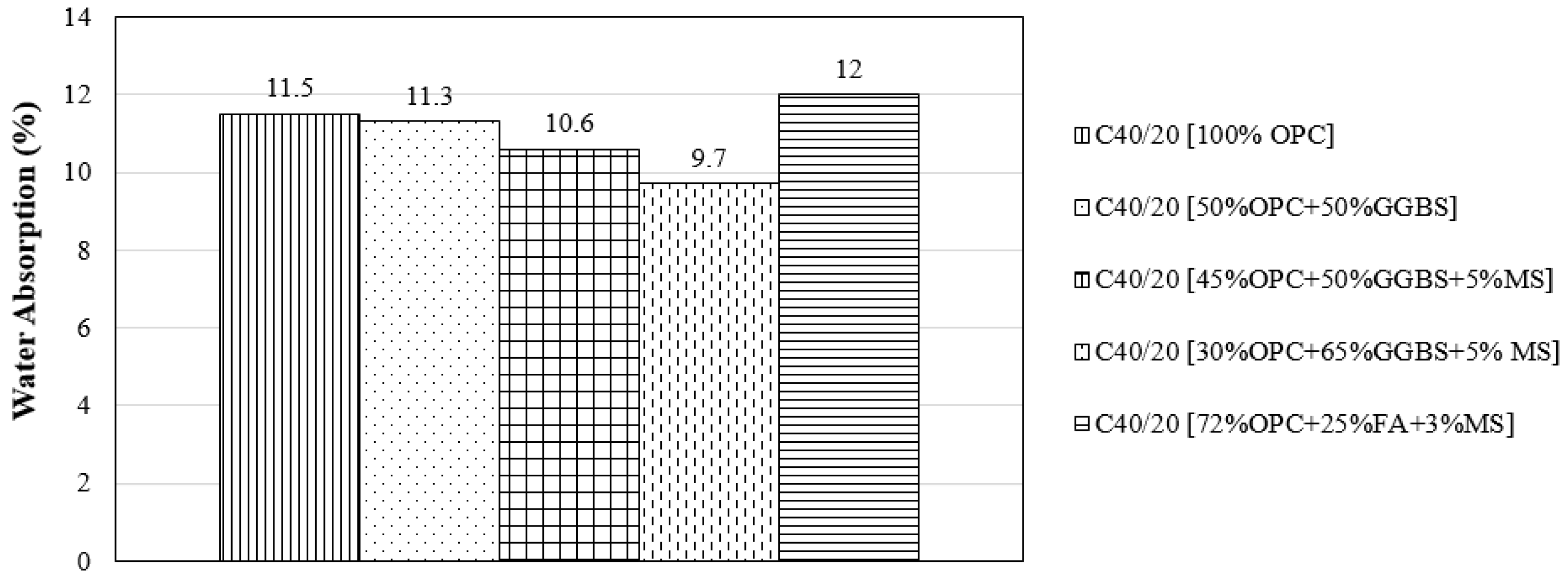
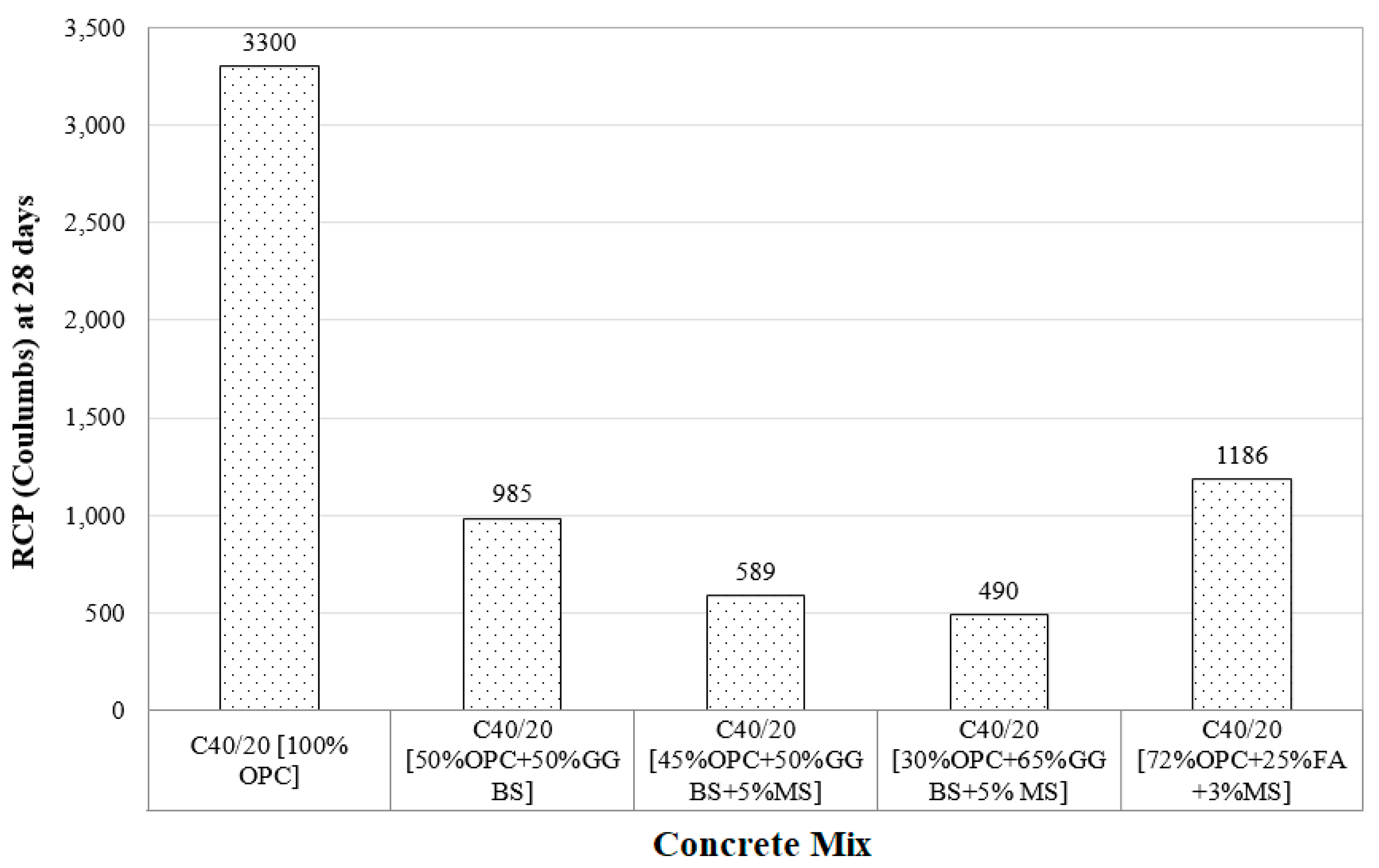
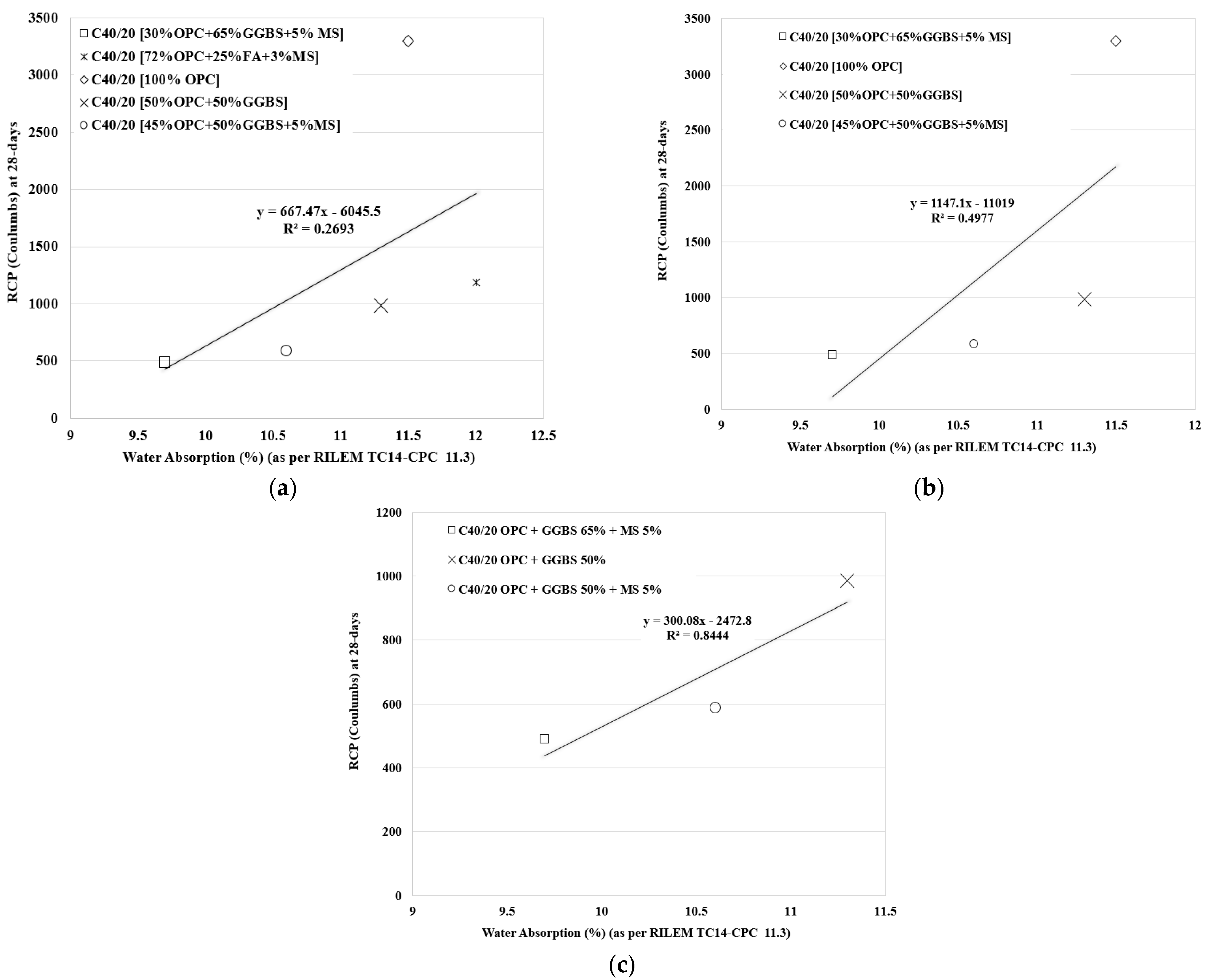
| Test Method | Standard Codes of Tests |
|---|---|
| Determination of water absorption | BS 1881: Part 122: 1983—Method for determination of water absorption |
| Absorption of water by concrete by immersion | RILEM CPC 11.1—RILEM Technical recommendations for the testing and use of construction materials |
| Absorption of water by concrete by immersion under vacuum | RILEM CPC 11.3—RILEM Technical recommendations for the testing and use of construction materials |
| Method for Density, Absorption, and Voids in Hardened Concrete | ASTM C 642–97—Standard test method for density, absorption and voids in Hardened Concrete |
| RCP Test after 28 days of curing | ASTM C1202–19—Standard test method for electrical indication of concrete’s ability to resist chloride ion penetration |
| Exp. Study | Concrete Mix | Parameters of Study | Codes and Method |
|---|---|---|---|
| I | OPC(100%) OPC(50%) + GGBS(50%) OPC(45%) + GGBS(50%) + MS(5%) | Water Absorption (%) | BS 1881: Part 122: 1983 RILEM CPC 11.1 RILEM CPC 11.3 ASTM C642 |
| II | OPC(100%) OPC(50%) + GGBS(50%) OPC(45%) + GGBS(50%) + MS(5%) OPC(30%) + GGBS(65%) + MS(5%) OPC(72%) + FA(25%) + MS(3%) | Water Absorption (%) RCP (Coulomb) at 28-day | RILEM CPC 11.3 ASTM C1202-19 |
| Concrete Mix | w/c | Cementitious Materials (kg/m3) | Coarse Aggr. | Fine Aggr. | |||
|---|---|---|---|---|---|---|---|
| OPC | GGBS | MS | FA | ||||
| OPC(100%) | 0.35 | 400 | - | - | - | 208 | 192 |
| OPC(50%) + GGBS(50%) | 0.35 | 200 | 200 | - | - | 208 | 192 |
| OPC(45%) + GGBS(50%) + MS(5%) | 0.35 | 180 | 200 | 20 | - | 208 | 192 |
| OPC(30%) + GGBS(65%) + MS(5%) | 0.35 | 120 | 260 | 20 | - | 208 | 192 |
| OPC(72%) + FA(25%) + MS(3%) | 0.35 | 288 | - | 12 | 100 | 208 | 192 |
| (A) Chemical composition of OPC, GGBS, MS and FA | ||||
| Chemical Component | OPC (%) | GGBS (%) | MS (%) | FA (%) |
| Silicon dioxide (SiO2) | 20.50 | 36.39 | 91.17 | 53.5 |
| Alumina (Al2O3) | 4.92 | 14.08 | 0.17 | 12.98 |
| Iron oxide (Fe2O3) | 3.88 | 1.08 | 0.04 | 7.03 |
| Calcium oxide (CaO) | 63.36 | 41.37 | 0.69 | 20.87 |
| Sulphur trioxide (SO3) | 2.47 | 0.45 | 0.004 | 0.67 |
| Magnesium oxide (MgO) | 1.01 | 7.0 | 0.56 | 3.48 |
| Sodium oxide (Na2O) | 0.54 | 0.55 | 0.58 | 1.50 |
| Potassium oxide (K2O) | - | 0.36 | 2.01 | - |
| Tri-calcium aluminate (C3A) | 6.48 | - | ||
| Chloride content | 0.01 | 0.02 | 0.04 | |
| Loss on ignition | 2.92 | 2.4 | 1.8 | 0.11 |
| Insoluble residue | 0.8 | - | ||
| Moisture Content | 0.38 | 0.55 | 0.02 | |
| (B) Physical properties of ingredients used in concrete mix | ||||
| 1. Ordinary Portland cement | ||||
| Fineness Specific Surface (m2/kg) (EN 196-6:2010) | 342 | |||
| Initial Setting time (min) (EN 196-3:2016) | 140 | |||
| Final Setting time (min) (EN 196-3:2016) | 185 | |||
| Soundness Le Chatelier Expansion (mm) (EN 196-3:2016) | 1.0 | |||
| Compressive Strength of Mortar Prism (MPa) (EN 196-1:2016) | ||||
| 2-day | 24.4 | |||
| 7-day | 38.7 | |||
| 28-day | 52.2 | |||
| Blaine Fineness (m2/kg) | 342 | |||
| 2. 50%OPC + 50%GGBS | ||||
| Initial Setting time (min) | 190 | |||
| Activity Index (%) | ||||
| 7-day | 64 | |||
| 28-day | 92 | |||
| 3. Silica Fume—Oversize percent retained on a 45 μm (324 sieve) | 0.53% | |||
| Accelerated pozzolanic strength activity index with OPC (7-day) | >110% | |||
| Specific surface (m2/g) | >18 | |||
| 4. Fly Ash—Percent retained on a 45 μm (324 sieve) | 9.8 | |||
Publisher’s Note: MDPI stays neutral with regard to jurisdictional claims in published maps and institutional affiliations. |
© 2021 by the authors. Licensee MDPI, Basel, Switzerland. This article is an open access article distributed under the terms and conditions of the Creative Commons Attribution (CC BY) license (https://creativecommons.org/licenses/by/4.0/).
Share and Cite
Kewalramani, M.; Khartabil, A. Porosity Evaluation of Concrete Containing Supplementary Cementitious Materials for Durability Assessment through Volume of Permeable Voids and Water Immersion Conditions. Buildings 2021, 11, 378. https://doi.org/10.3390/buildings11090378
Kewalramani M, Khartabil A. Porosity Evaluation of Concrete Containing Supplementary Cementitious Materials for Durability Assessment through Volume of Permeable Voids and Water Immersion Conditions. Buildings. 2021; 11(9):378. https://doi.org/10.3390/buildings11090378
Chicago/Turabian StyleKewalramani, Manish, and Ahmad Khartabil. 2021. "Porosity Evaluation of Concrete Containing Supplementary Cementitious Materials for Durability Assessment through Volume of Permeable Voids and Water Immersion Conditions" Buildings 11, no. 9: 378. https://doi.org/10.3390/buildings11090378
APA StyleKewalramani, M., & Khartabil, A. (2021). Porosity Evaluation of Concrete Containing Supplementary Cementitious Materials for Durability Assessment through Volume of Permeable Voids and Water Immersion Conditions. Buildings, 11(9), 378. https://doi.org/10.3390/buildings11090378





